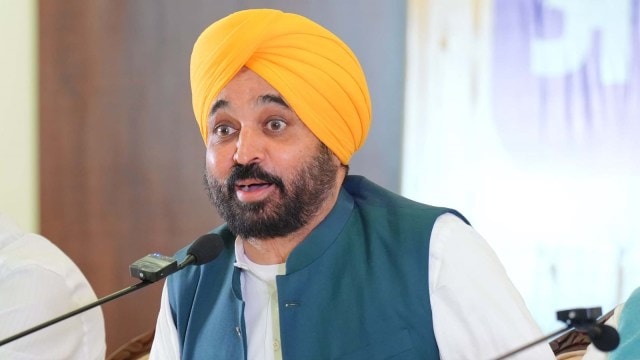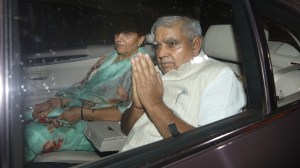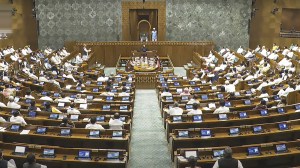Punjab won’t withdraw free electricity schemes, CM Bhagwant Mann makes it clear; govt chalks out long-term plan to rationalise subsidies
Punjab has prepared an ambitious rationalisation plan under which 80 per cent of the agriculture power feeders and 100 per cent of the domestic power feeders will be powered by solar energy by 2047
 Mann and Purohit had been on a confrontational path since July 2022, when the Governor visited the border areas of the state and made a statement that drugs were available freely in the state and had reached schools too. (File)
Mann and Purohit had been on a confrontational path since July 2022, when the Governor visited the border areas of the state and made a statement that drugs were available freely in the state and had reached schools too. (File)Unlike the neighbouring state of Himachal Pradesh, which had withdrawn the power subsidy given to the people in order to get financial help from the 16th Finance Commission, Punjab said it will continue to give free electricity to the agriculture sector and up to 300 free units of power to the domestic sector.
Sources in the government said Chief Minister Bhagwant Mann has made it clear that he would not touch the power subsidy. “He has said that this has to continue. There is no bailout. We have to think of other ways to lessen the burden of subsidy on the state exchequer,” the source added. In fact, Punjab Finance Minister Harpal Cheema had on Wednesday said the free electricity schemes will continue.
Meanwhile, Punjab has prepared an ambitious rationalisation plan under which 80 per cent of the agriculture power feeders and 100 per cent of the domestic power feeders will be powered by solar energy by 2047. The government has also chalked out a plan to solarise all institutional and industrial buildings by 2031.
Notably, the incumbent Aam Aadmi Party’s (AAP) term will come to an end in March 2027 unless it is re-elected in the 2027 Assembly elections.
Himachal Pradesh’s decision to withdraw the subsidy had pressed a panic button in Punjab. However, the state government prepared an extensive plan for the subsidy.
After a presentation to the Finance Commission on July 22, the central body’s chairman, Dr Arvind Panagariya, appeared “soft” on the subsidy despite his known stand against subsidies. He had told the media that “rationalisation on subsidy was to be done by the state concerned (Punjab)”.
What is the plan
As per the plan, the government has targeted 75,000 grid substation-connected agriculture tubewells to be solarised in the current fiscal. At the same time, 66 grid substations of the state’s total 1,000 would be solarised too.
“Tariff based competitive bidding under Renewable Energy Service Company (RESCO) mode is being shortly invited for setting up of solar power plants of 4MW capacity each at the 66 KV sub-stations in the state. These will be 66 in number. A total capacity addition of 264 MW of solar power projects shall be done for solarisation of agricultural power needs in the state,” a government official said.
These 264MW capacity projects shall also be eligible for a central financial assistance of Rs 270 crore from the Ministry of New and Renewable Energy. Estimated generation of 400 Million Units (MUs) from these solar power projects shall replace agriculture power of the same quantum, said officials. “If electricity has a tariff of Rs 3 per unit, there will be an estimated savings of Rs 148 crore per annum even if the agriculture power subsidy is given.”
To power 14.5 lakh agriculture pumps across Punjab, the state government pays an annual subsidy of almost Rs 10,000 crore. Almost 82 per cent domestic consumers are also given 300 units of free power every year. It rises to 92 per cent and even more during the winter months. In the industrial sectors too, the government provides subsidies at different rates.
Punjab’s free power bill has crossed Rs 20,200 crore this fiscal. However, the government’s rationalisation plan does not mean a significant immediate relief to the exchequer.
Solarisation plan not new
This is not the first time that the government has chalked out a solarisation plan. It was first started in former Chief Minister Parkash Singh Badal’s second term from 2012 to 2017. At that time, the subsidy bill was Rs 5,000 crore annually.
However, financial issues did not allow Badal to adopt solarisation as at that time, every unit of solar power cost Rs 13-14. Then former Finance Minister Manpreet Singh Badal also chalked out a similar plan during former Chief minister Amarinder Singh’s regime.
He had planned to run each tube well in the state on solar power by spending Rs 2 lakh. This meant an expenditure of Rs 29,000 crore. This never saw the light of the day. The incumbent government is the third successive government to have a plan. However, now, solar power is cheaper and each unit is available at Rs 2 to Rs 3.
‘Plan to help domestic sector’
As per a study by the Punjab Agricultural University (PAU), farmers use free power on their pump sets for 100 days in a year. The solar power generators do not work properly in Punjab for 64 days due to fog and smog. For the rest of the 200 days of the year, farmers do not need electricity for agricultural purposes.
As per the plan, private companies will be invited to set up solar power plants in the villages that are being identified by the government.
The 200 days, when the farmers would not need power supply, these solar plants would supply the power to the substations. From there, it would be routed to the domestic consumers. This way, the government plans to save on domestic power subsidies too.
Scheme to pay Rs 1,100 every month to women yet to be rolled out
Panagariya said 95 per cent of Punjab’s subsidy is being used to provide free power. Punjab has also been paying Rs 650 crore every year towards free travel for women. Another freebie, promised by the Aam Aadmi Party before the elections, was Rs 1,000 every month to all women voters. However, it remained a non-starter.
In the recent Lok Sabha elections, Mann had promised that he would pay Rs 1,100 instead of Rs 1,000 soon. The freebie is set to cost the state Rs 12,000 crore annually, thereby burdening it even further. However, sources said that the government is not in a position to roll this out.












